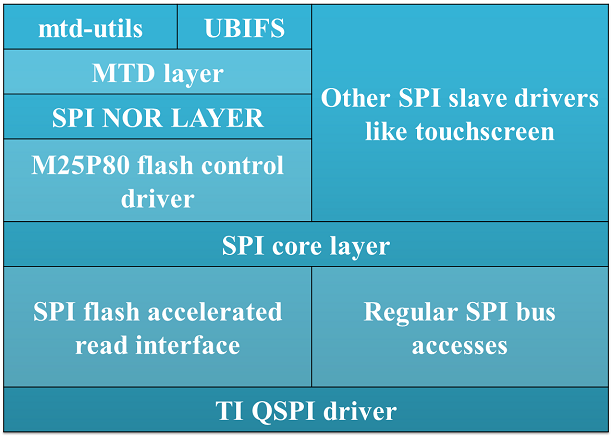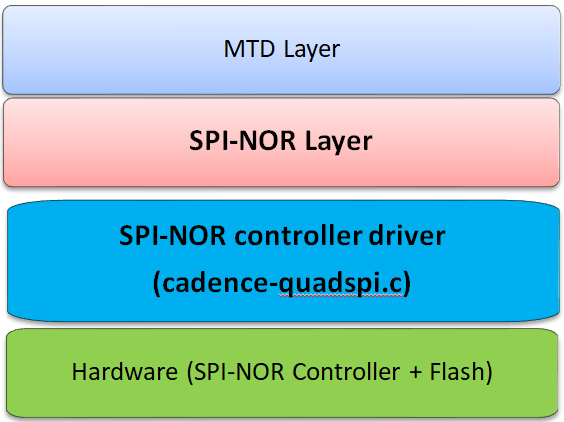3.2.4.13. OSPI/QSPI¶
Introduction
Octal Serial Peripheral Interface (OSPI) is a SPI module that has x8 IO lines. Quad Serial Peripheral Interface (QSPI) has x4 IO lines. These controllers are mainly used to interface with Octal or Quad SPI flashes. OSPI is backward compatible with QSPI. These modules can also work in dual (x2) and single (x1) modes.
OSPI and QSPI controllers on TI SoCs support memory mapped IO interfaces, which provide a direct interface for accessing data from the external SPI flash, thereby simplifying software requirements. These controllers work only in master mode.
Supported Devices
There are two variants of OSPI/QSPI controller IPs on various TI SoCs. The table below provides a mapping of driver and capabilities for different TI SoCs:
| SoC Family | capability | Driver |
|---|---|---|
| AM437x | QSPI | drivers/spi/spi-ti-qspi.c |
| DRA7xx/AM57xx | QSPI | drivers/spi/spi-ti-qspi.c |
| 66AK2Gx | QSPI | drivers/mtd/spi-nor/cadence-quadspi.c |
| AM654/J721e | 1x OSPI, 1x QSPI | drivers/mtd/spi-nor/cadence-quadspi.c |
Driver Features
OSPI controllers support Double Data Rate (DDR) mode in Octal configuration wherein data can be read on both edges of the clock.
Note
Driver does not support Octal or Quad mode writes.
Memory mapped read support
Once the controller is configured in memory map mode, the whole flash memory is available as a memory region at SoC specific address. This region can be accessed using normal memcpy() (or mem-to-mem dma copy). Controller hardware will internally communicate with SPI flash over SPI bus and get the requested data. This mode provides the best throughput and is the default mode in the SDK.
Supported SPI modes
spi-ti-qspi.c driver supports all clock and polarity modes defined in the table “SPI Clock Modes Definition” of particular SoC’s TRM. But make sure that the selected mode is supported by the clocking requirements of the device as per the device’s datasheet.
cadence-quadspi.c driver supports standard SPI mode 0 only.
DMA support
Driver uses mem-to-mem DMA copy on top of OSPI/QSPI memory mapped port during read from flash for maximum throughput and reduced CPU load.
Driver Architecture
Following diagram shows the QSPI driver stack:

Fig. 3.1 QSPI driver software stack
The QSPI driver can be used both to access SPI flash devices via mtd subsystem or access generic SPI devices (like SPI touchscreen) via SPI framework.
The OSPI driver stack is shown in the following diagram:

Fig. 3.2 OSPI driver software stack
OSPI does not support interfacing with non flash SPI slaves.
Driver Configuration
Source Location
The source file for the QSPI driver can be found at: drivers/spi/spi-ti-qspi.c under Linux kernel source tree.
OSPI driver is at: drivers/mtd/spi-nor/cadence-quadspi.c under Linux kernel source tree. This driver also supports QSPI version of the same IP.
Kernel Configuration Options
The driver can be built into the kernel or can be compiled as module and loaded into the kernel dynamically.
Enabling OSPI/QSPI Driver Configurations
Following needs to be enabled to access OSPI/QSPI flash: TI QSPI controller driver, SPI NOR framework and MTD M25P80 generic serial flash driver in the kernel via menuconfig.
Note
OSPI/QSPI drivers and their dependencies are enabled by default in the SDK images. So this section can be skipped in that case.
Start the Linux Kernel Configuration tool:
$ make menuconfig ARCH=arm
To enable QSPI controller driver:
Device Drivers --->
[*] SPI support --->
<*> DRA7xxx QSPI controller support
To enable SPI NOR framework:
Device Drivers --->
<*> Memory Technology Device (MTD) support --->
<*> SPI-NOR device support --->
To enable M25P80 generic SPI flash driver:
Device Drivers --->
<*> Memory Technology Device (MTD) support --->
Self-contained MTD device drivers --->
<*> Support most SPI Flash chips (AT26DF, M25P, W25X, ...)
To enable cadence-quadspi driver:
Device Drivers --->
<*> Memory Technology Device (MTD) support --->
<*> SPI-NOR device support --->
<*> Cadence Quad SPI controller
To enable them as modules, make <*> as <M>.
Enabling UBIFS filesystem support:
File systems --->
[*] Miscellaneous filesystems --->
<*> UBIFS file system support
DT Configuration
Refer to Documentation/devicetree/bindings/spi/ti_qspi.txt under kernel source tree for spi-ti-qspi controller driver’s DT bindings and their usage.
For cadence-quadspi controller refer to Documentation/devicetree/bindings/mtd/cadence-quadspi.txt for DT bindings and their usage.
To configure OSPI/QSPI flash partitions and flash related DT bindings refer to Documentation/devicetree/bindings/mtd/jedec,spi-nor.txt and Documentation/devicetree/bindings/mtd/partition.txt.
Driver Usage
Note
Although OSPI and QSPI are different at hardware level, from Linux point of view, both OSPI and QSPI are managed in the same way and are exposed as /dev/mtdX devices to the user space. Therefore, there is virtually no difference to end user even though OSPI and QSPI use different drivers underneath. Therefore this section applies to both OSPI and QSPI.
Load QSPI or OSPI module as required using modprobe (this will take care of dependencies and load those modules as well):
$modprobe spi-ti-qspi
$modprobe cadence-quadspi
This should create /dev/mtdX entries for every partition defined in DT or via command line arguments. MTD abstracts all types of flashes and, therefore, both OSPI and QSPI appear as MTD devices. To see all MTD partitions in the system run:
$cat /proc/mtd
Here is an example output (name varies depending on what is passed in DT or via command line arguments):
dev: size erasesize name
mtd0: 00080000 00010000 "QSPI.U_BOOT"
mtd1: 00080000 00010000 "QSPI.U_BOOT.backup"
mtd2: 00010000 00010000 "QSPI.U-BOOT-SPL_OS"
mtd3: 00010000 00010000 "QSPI.U_BOOT_ENV"
mtd4: 00010000 00010000 "QSPI.U-BOOT-ENV.backup"
mtd5: 00800000 00010000 "QSPI.KERNEL"
mtd6: 036d0000 00010000 "QSPI.FILESYSTEM"
Testing
Using mtd-utils
$ cat /proc/mtd /* Should list QSPI partitions */
$ flash_erase /dev/mtd6 0 0 /* Erase entire /dev/mtd6 */
$ dd if=/dev/random of=tmp_write.txt bs=1 count=num /* num = bytes to write to flash */
$ mtd_debug write /dev/mtd6 0 num tmp_write.txt /* write to num bytes to flash */
$ mtd_debug read /dev/mtd6 0 num tmp_read.txt /* /* read to num bytes to flash */
$ diff tmp_read.txt tmp_write.txt /* should be NULL */
Using dd command
$ cat /proc/mtd /* Should list QSPI partitions */
$ flash_erase /dev/mtd6 0 0 /* Erase entire /dev/mtd6 */
$ dd if=/dev/random of=tmp_write.txt bs=1 count=num /* num = bytes to write to flash */
$ dd if=tmp_write.txt of=/dev/mtd6 bs=num count=1 /* write to num bytes to flash */
$ dd if=/dev/mtd6 of=tmp_read.txt bs=num count=1 /* read to num bytes to flash */
$ diff tmp_read.txt tmp_write.txt /* should be NULL */
Using UBIFS on flash
Make sure UBIFS filesystem is enabled in the kernel (refer to this section for more information).
root~# ubiformat /dev/mtd9
ubiformat: mtd9 (nor), size 23199744 bytes (22.1 MiB), 354 eraseblocks of 65536 bytes (64.0 KiB), min. I/O size 1 bytes
libscan: scanning eraseblock 353 -- 100 % complete
ubiformat: 354 eraseblocks are supposedly empty
ubiformat: formatting eraseblock 353 -- 100 % complete
root:~# ubiattach -p /dev/mtd9
[ 270.874428] ubi0: attaching mtd9
[ 270.914131] ubi0: scanning is finished
[ 270.921788] ubi0: attached mtd9 (name "QSPI.file-system", size 22 MiB)
[ 270.928405] ubi0: PEB size: 65536 bytes (64 KiB), LEB size: 65408 bytes
[ 270.935210] ubi0: min./max. I/O unit sizes: 1/256, sub-page size 1
[ 270.941491] ubi0: VID header offset: 64 (aligned 64), data offset: 128
[ 270.948102] ubi0: good PEBs: 354, bad PEBs: 0, corrupted PEBs: 0
[ 270.954215] ubi0: user volume: 0, internal volumes: 1, max. volumes count: 128
[ 270.961602] ubi0: max/mean erase counter: 0/0, WL threshold: 4096, image sequence number: 2077421476
[ 270.970887] ubi0: available PEBs: 350, total reserved PEBs: 4, PEBs reserved for bad PEB handling: 0
[ 270.980204] ubi0: background thread "ubi_bgt0d" started, PID 863
UBI device number 0, total 354 LEBs (23154432 bytes, 22.1 MiB), available 350 LEBs (22892800 bytes, 21.8 MiB), LEB size 65408 bytes (63.9 KiB)
root:~# ubimkvol /dev/ubi0 -N flash_fs -s 20MiB
Volume ID 0, size 321 LEBs (20995968 bytes, 20.0 MiB), LEB size 65408 bytes (63.9 KiB), dynamic, name "flash_fs", alignment 1
root:~# mkdir /mnt/flash
root:~# mount -t ubifs ubi0:flash_fs /mnt/flash/
[ 326.002602] UBIFS (ubi0:0): default file-system created
[ 326.008309] UBIFS (ubi0:0): background thread "ubifs_bgt0_0" started, PID 866
[ 326.027530] UBIFS (ubi0:0): UBIFS: mounted UBI device 0, volume 0, name "flash_fs"
[ 326.035157] UBIFS (ubi0:0): LEB size: 65408 bytes (63 KiB), min./max. I/O unit sizes: 8 bytes/256 bytes
[ 326.044615] UBIFS (ubi0:0): FS size: 20341888 bytes (19 MiB, 311 LEBs), journal size 1046528 bytes (0 MiB, 16 LEBs)
[ 326.055123] UBIFS (ubi0:0): reserved for root: 960797 bytes (938 KiB)
[ 326.061610] UBIFS (ubi0:0): media format: w4/r0 (latest is w4/r0), UUID 828AA98E-3A51-4B35-AD50-9E90144AD4C7, small LPT model
root:~#
Now you can access filesystem at /mnt/flash/.
